Many people believe SEO is an incredibly complex topic. I'm here to tell you that this is not the case. I believe it's incredibly simple. So long as you adhere to the "five pillars" of SEO.
In this article, I will talk more about these five pillars, and how we have used them to increase our monthly organic traffic by 96% since the turn of the year.
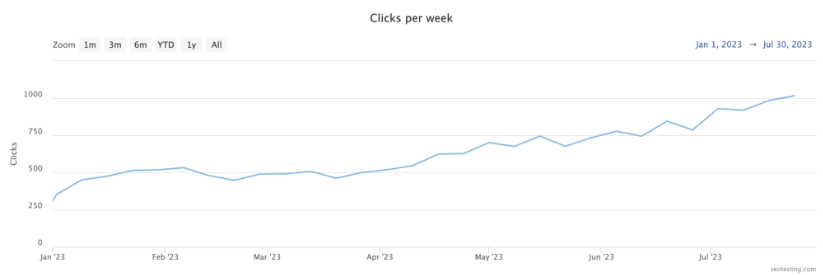
There is a lot of information on the web about what the five pillars of SEO are. I'm here today to give my take, having done SEO for over 8 years.
This advice will be slightly different to other articles on this topic, but I truly believe that getting these things right will allow you to improve your organic traffic and the revenue coming to your website.
Laying the Foundation - Technical SEO
Yes, I know that I haven't mentioned technical as one of the five pillars of SEO. That's because I believe it is more important.
I am using the metaphor of foundations to describe your website's technical SEO as I genuinely believe your website will not see meaningful results in the SERPs unless it sits soundly from a technical perspective.
This is especially true for large sites with thousands, hundreds of thousands or even millions of pages. The larger your website is, the greater focus you need to divert to your website's technical SEO.
Sitemaps
Having your XML sitemap uploaded to Google Search Console and other tools like Bing Webmaster Tools, is crucial to getting your web pages crawled, indexed and ranked as quickly as possible.
Any site, no matter the size, will have its sitemap crawled regularly by Googlebot and other search engine bots to find new pages that it has not yet found through internal links or manual submission. So keeping your sitemap up to date through your webmaster tools software is also of vital importance.
Within Google Search Console, you can do this through the "Sitemaps" section, found within your indexing reports:
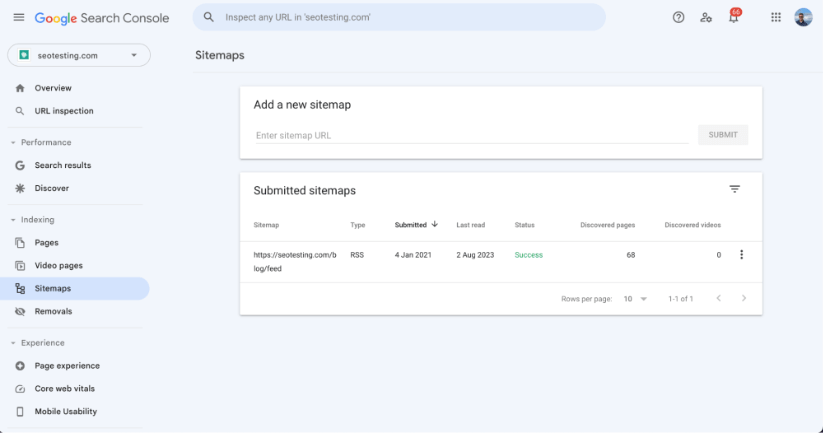
It's also worth noting that you can upload multiple sitemaps through Google Search Console. This is not necessary when you have a smaller website, but becomes much more useful when you are working on a larger site.
As sites get larger and larger, the management of your crawl budget (the amount of resources Google dedicates to crawling a particular website), becomes more and more important. If you find yourself managing a website with millions of pages, having multiple sitemaps is the best way to ensure your pages are crawled efficiently and the most important sections and pages of your site get the most attention.
Site Structure
Ensuring you have a great website structure is crucial to your success as a website, large or small.
You have a real chance here to control how important Google sees different pages and sections of your website, as well as how users navigate your site which will impact on-site metrics like bounce rate and conversion rate, which will (in turn) impact your website's profitability.
Luckily, the structure of your website is a relatively simple thing to master. List the most important sections of your website, such as:
- Homepage
- Ecommerce category pages
- Lead magnets
- Service information pages
At the top of your website, in the header. Google will be able to read this and see that you are treating these pages as the most important pages on your site, giving more weight to these pages.
At the bottom of your website, list pages of lesser importance, such as:
- Terms and conditions pages
- Privacy policies
In the footer section of your website. That way, they are still easy to find for users who need to see them, but Google will see them as lesser pages and not, necessarily, rank them as highly. You can, of course, still rank these pages, but it is harder. So add pages you do not need to rank in the footer section of your site.
The next step is to ensure your website's internal links are well structured, ideally creating a "hub and spoke" structure for your website. The hub and spoke method is one of the most popular website organisation structures, for good reason. This will allow you to create subtopics within your website, all interlinking between the relevant pages. This will hold link equity where it needs to be held, make your website easy for both users and search engines to navigate and, hopefully, increase your website's chances of ranking for your chosen topics.
The goal of the hub and spoke method of content structure is to ensure no link equity is wasted. Of course, you should link to other pages on your website that are relevant to the content as standard, but ensure the bulk of the links and interlinking between different topics.
We have a good example of this with our Google Search Console content hub. We have our "Google Search Console" starter page, which links out to all of our GSC content, whether it's a guide on how to use GSC for keyword research or information on different indexing errors. Each of these pieces will link back to the central content hub, and interlink between themselves where necessary.

The above is an example of a good website structure. You can see the homepage header links out to all of the ecommerce category pages. This is going to give maximum link equity to these pages, giving them the best chance at ranking.
It works.
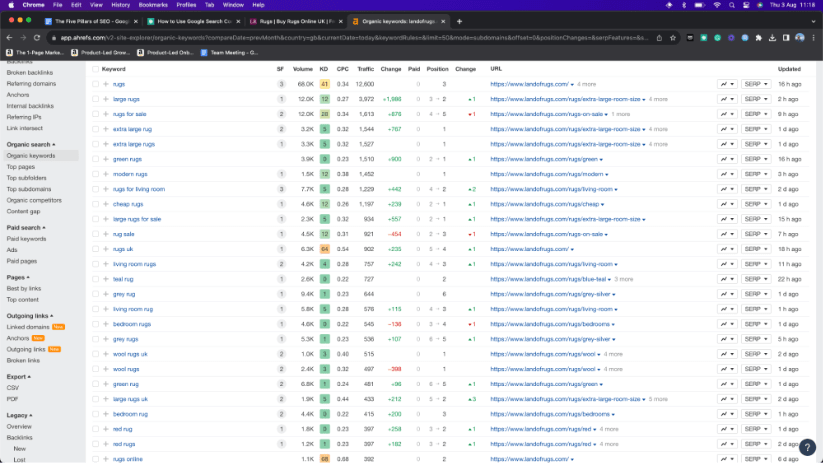
This is a screenshot from Ahrefs showing Land of Rugs' organic rankings. As you can see, they are doing very well ranking their product listing pages where they need to be ranked to get maximum traffic to these pages.
Website Speed
Having a fast website is crucial. According to a 2023 article from Blogging Wizard, a website that loads in one second can expect to receive 30.5 new sales for every 1,000 visitors. That number drops to 16.8 sales for a website that takes two seconds to load. For a website that takes three seconds to load, the number drops to 10.8 sales.
Whether you are an ecommerce website or not, site speed is crucial.
You can improve your site speed with the aid of a Google tool, Google Lighthouse. This will crawl your website as a search engine bot does, and give you feedback on different elements making your website slower than it could be.
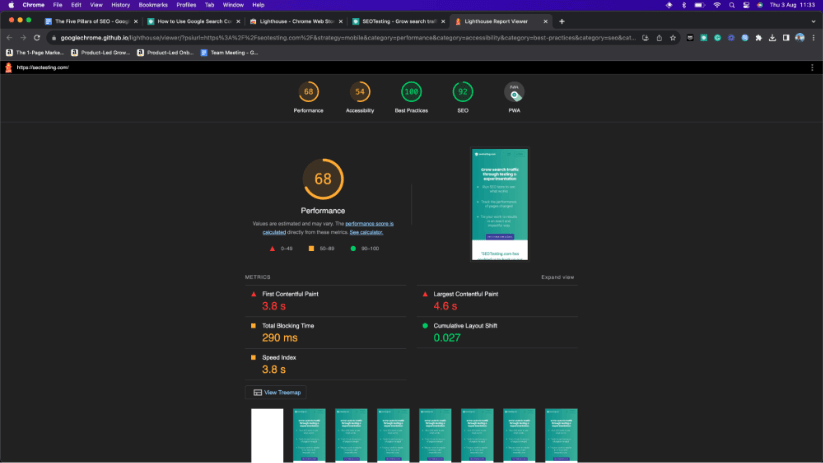
This is a Lighthouse report I have just run on the SEOTesting website. As you can see, it has an overall score of 68 so there are some areas to improve.
Mainly, we need to improve our First Contentful Paint and Largest Contentful Paint, these are the two things adding the biggest loading time to our site.
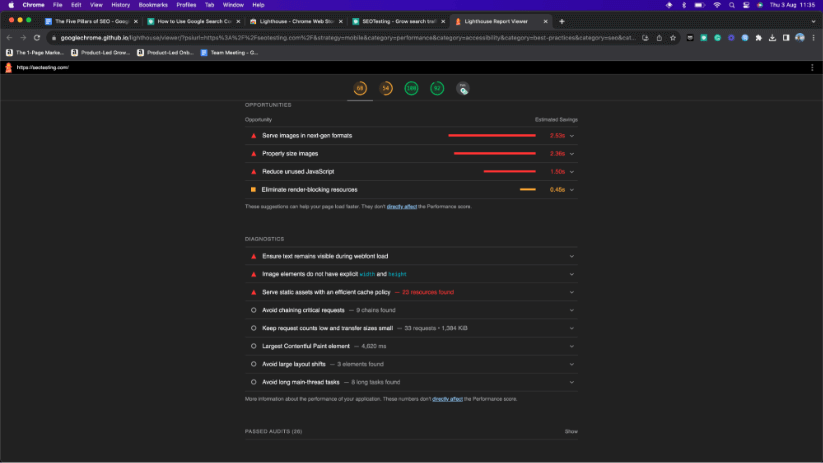
Scrolling further down within the report, we can see the things we can do to our site to make it faster, as well as the estimated time savings we could make by doing these different things.
We could, potentially, make our site 2.53 seconds faster by serving images in next-gen formats. A relatively simple, but time-consuming change.
What this report does is allow me to confidently convey to our developers what needs to be done on the site to make it faster. This is even more important now that Google has confirmed that your Core Web Vitals scores are a ranking factor. It's not every day that Google confirms different ranking factors, and it might have a small weight but improving our scores will give our site a better chance at ranking.
Mobile-Friendliness
In 2023, your website needs to be mobile-responsive. As of August 2023, 56.66% of all web traffic came from a mobile device. To add some context, in 2015, the figure was 31.16%.
You can use Google Search Console to analyse your website and find out if your website is mobile-friendly:
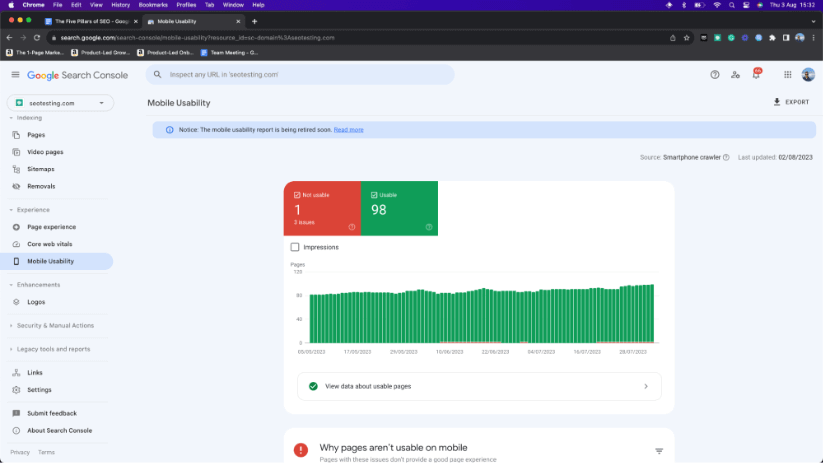
This report, within GSC, takes all of your crawled web pages and lets you know if any of them have issues with viewing on a mobile device. As you can see from our screenshot above, one of them has.
Scrolling down, Google explains what the issue is:
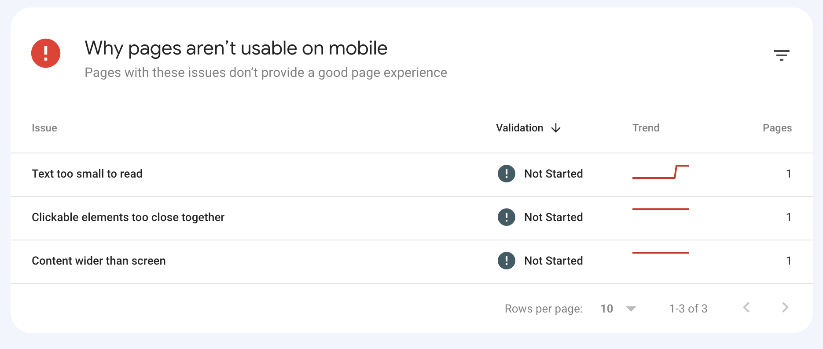
We can see that, on one of our pages, the text is too small to read. We just need to head into the back end of this page and increase the text size to ensure it is fully readable. We can also see that we have some clickable elements too close together, and content wider than the screen. All of these issues are on the same page.
This report is great, for small and large sites, as it tells you in detail which pages have mobile usability problems and which ones do not. It also tells you what the problems are that need to be solved.
Pillar 1 - Customer (& Keyword) Research
When in the research phase of your SEO campaigns, there are two crucial things you need to ensure your research is complete. Your customers, and the keywords they are searching to find the products and services that meet their needs.
Find your Customers & Their Needs
Finding your customers and what they require from businesses is crucial, but luckily, there are multiple ways to do this.
Ignoring social media, which you will always be able to find customers on, there are communities like Reddit and Quora. These two sites in particular are great for finding your ideal customers. They have millions of topics, so you can find topics related to your business activities and start posting there and researching what your customers need and trending topics within your industry.
For example, SEOTesting is a marketing company at heart, so we may search Quora and Reddit for topics like marketing, digital marketing, SEO, and keyword research. We are sure to find topics like these. Once you have found these communities, you can start looking at the questions your target audience is asking, and planning content to answer those questions and show how your product/service can help.
Sparktoro is another great tool for this, it specialises in finding who your customers are, what they talk about and, most importantly, where to reach them.
Here's an example of our business. We know our audience is going to talk about SEO testing, so we will plug this term into Sparktoro.
Now, we can see what our audience looks like (titles in their job roles), we can see what hashtags they frequently use, and we can see the phrases they frequently use:
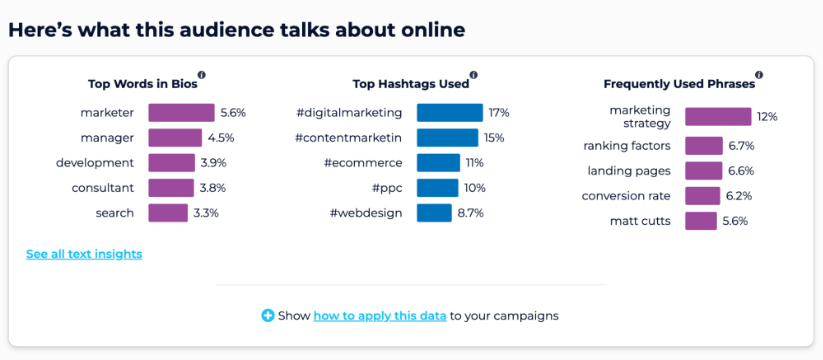
We can also see what social accounts they follow most, what websites they visit most and some hidden gems for each category:
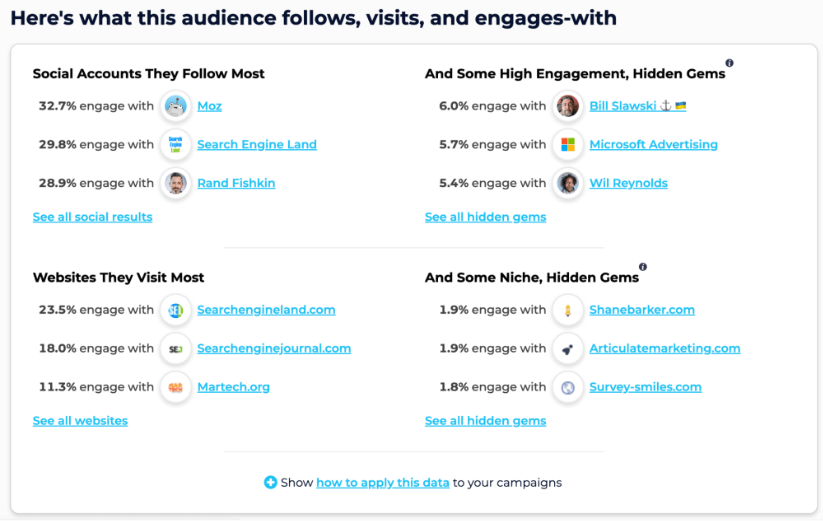
Finally, we can see what our audience watches, listens to and read:
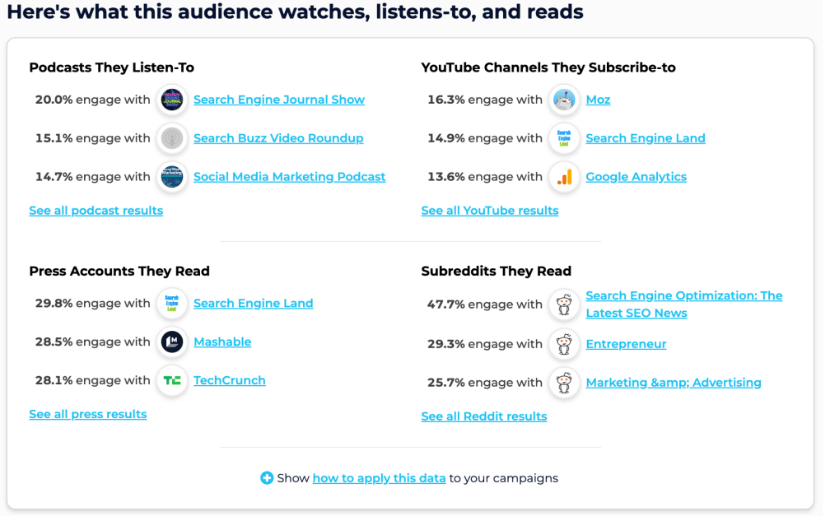
This is all really good information. We now know the subreddits we need to be active on, and we have ideas as to the press accounts we should target for features, what podcasts we should try and get appearances on as well as what hashtags they use when they post to their social media accounts. All of this is going to allow us to get to know our audience more and get in front of them with our content and our solutions.
Find your Queries
Finding the queries people use to find businesses like yours is another crucial step to success, hence why it is included in the first pillar of a successful SEO campaign. There are several things you can do and tools you can use to make this process easier:
Tools like Google Keyword Planner and Google Autocomplete are great. You can start with a seed keyword (like SEO testing) and find other related topics people are searching for that are relevant to that seed query. For example, if we search Google for "SEO testing", we can see other related topics people are searching for:
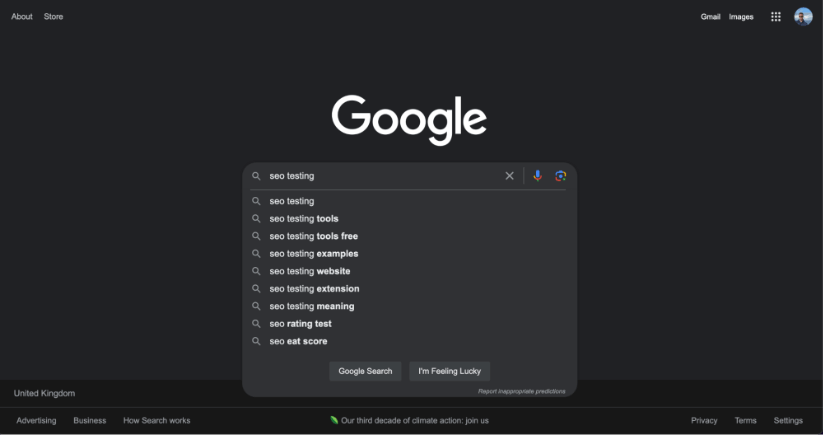
We can see people are searching for:
- SEO testing tools.
- Free SEO testing tools.
- Examples of SEO testing.
- A Chrome extension to aid SEO testing.
We can now go and create content for these keywords to ensure we reach more of our target audience.
Tools like AlsoAsked work in a similar way. Start with a seed keyword and the tool will extract all the questions from Google's People Also Ask tool automatically for you, and put it into an easy-to-read and understand graphic:
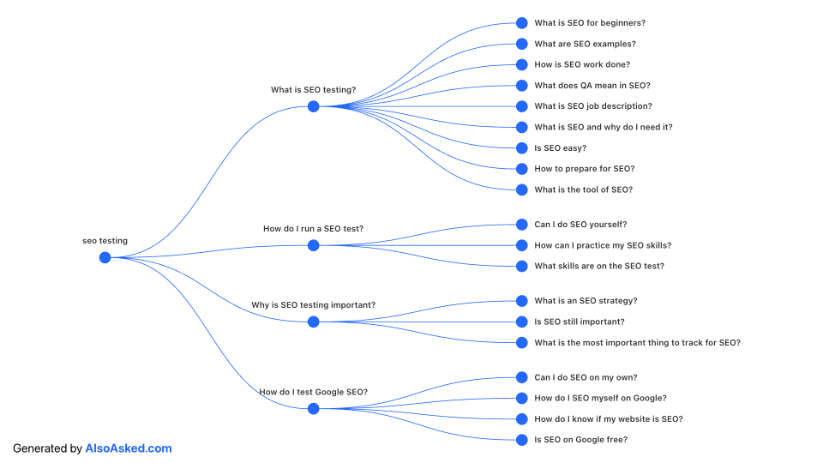
Thanks to tools like these, we know the questions people are asking and we know the questions we need to answer!
Read our guide to find the best free keyword research tools.
Examine the Intent of Your Queries
It's also worth noting that different queries have different intents. Some people will be searching keywords to find products to buy, some will be searching for an answer to a question. Keyword intent can be broken down into 4 sections:
- Informational
- Commercial
- Transactional
- Navigational
Informational searches are performed to find the answer to questions. For example, if I was looking to find who Tom Brady played for during his NFL career.
Commercial searches are performed to prepare for a transaction, they allow the searcher to do more research before they purchase. Best road running shoes and best mountain bikes are good examples of commercial searches.
Transactional searches are performed when someone wants to buy something. Like, for example, if I wanted to purchase some Nike Air Force 1 shoes in red, I may search "red Nike Air Force 1 shoes for sale" or something similar.
Navigational searches are performed to take the user somewhere else. They may search a specific website like "seotesting.com" or "nfl.com". In this instance, they know where they need to go and they are using the search engine to get there.
Understanding the intent behind each of the queries you target is crucial. Content that works for transactional searches is not suitable for commercial or informational searches, and so on. You need to ensure you are creating content that matches search intent. This is SEO 101.
Pillar 2 - Content Creation & Distribution
Most SEO campaigns are won and lost during the content creation and distribution stage.
Of course, you have to create great content to have a chance of ranking, especially for those high-traffic top-of-funnel keywords, but if you don't distribute your content well, you will find it harder to get links, social shares and other traction that will aid your ranking.
Content Planning
If you want to create great content, you need to ensure it is being planned well. You must ensure you are aware of the pieces of content you are going to be competing against, what topics they cover and what perspectives they show within their content.
This is the same whether you are planning a blog post, a podcast or a YouTube video. You need to be prepared to create content that is better than the competition. Especially with those high-value, high-conversion keywords.
For an extra boost, you can plan content clusters using a tool like Keyword Insights or others. Tools like this will allow you to upload a bulk list of keywords, and the tool will cluster them, automatically. You'll then know what keywords need their own piece of content, and which keywords which can be thrown in together and targeted with one piece of content.
Content Writing
Content writing is, aside from proper research, probably the most important stage of SEO campaigns. As I've mentioned earlier, if you do not write great content, your work is going to have little chance of ranking for the keywords your business needs to rank for.
Once your research is complete, you need to write content that is easy to read and understand, covers every topic you found from your research, is not riddled with spelling & grammar errors, and you need to ensure the content length fits competitor pieces. If you are finding that ranking content is over 5,000 words for a particular topic, writing a blog post of 1,000 words or less might not have the best chance of competing.
Some tools will help with this. Online word counters are great for ensuring content length fits, a lot of these will also have "writing scores" as well which score your content on how easy it is to read and understand. Grammarly is a wonderful tool that will help you eliminate spelling and grammar mistakes. You can also make use of translation tools if you have multiple websites for different languages. This is a great way to get your content seen by more of your target audience.
Other Content Formats
As mentioned a little earlier, a successful SEO campaign doesn't just consist of written content. You also need to include video and other mediums like podcasts to improve your brand presence (which we will talk about a little later on in the article).
For example, creating a YouTube video to compliment blog posts is going to work on multiple levels.
It's going to, hopefully, improve your on-site metrics like time on page and bounce rate, and these videos will also help people understand your content more. It's also going to help away from your website. When these videos are uploaded to YouTube, you are reaching a new audience entirely. You will reach new people who may choose to subscribe to you and watch more of your videos.
As marketing moves more towards "zero-click marketing", you also need to ensure you are owning an audience. This is where email newsletters and podcasts will come in. Of course, you can use these content types to supplement your written content, but you can also use them to create value for this new audience. Your email newsletter subscribers could become dedicated fans, and it is the same with your podcast subscribers. When you own your audience, you can ensure you are successful even as Google and other search engines change.
Cross-Channel Distribution
Following on from creating multiple content types, you also need to ensure you are distributing your content across channels to give it the best chance of success.
Generally, when a company creates a blog post (for example), they may share this across their social media, try and build a few links to it and then leave it. But there are so many more avenues for distributing your content that these companies are missing out on.
Next time you publish a blog post, try something different:
- Share across your company's social media profiles.
- If any of your employees have a personal brand, share it here too.
- Share the content with prominent people within your industry.
- Share the content on relevant Reddit communities as a summary.
- For an extra boost, you can always sponsor newsletters and ask them to share.
Tim Stoddart also has a great take on converting a blog post into 22 pieces of content:
- Create one blog post.
- Turn the blog post into three LinkedIn posts.
- Turn the blog post into 8 tweets.
- Turn the tweets into short-form videos for TikTok, Instagram Shorts etc.
- Turn the blog post into a YouTube video.
- Send a summary of the blog post to your email list.
From one piece of content (the blog post) you now have 22 pieces of content to share!
Pillar 3 - Link Acquisition
Like it or not, links are still the backbone of the internet and are, in most cases, still the most significant ranking factor for most websites.
Of course, you can have success with your SEO without paying much attention to or actively building links. But this success is going to be much less than if you had put some time and money into building a link acquisition strategy.
The way businesses have built links has changed over the years. Link building in 2010 looks very different to the link building we see in 2023, and often what worked in 2010 does not work anymore.
Below you'll find my three key pieces of advice to keep in mind when building links for your business.
No Cold Outreach
This is an approach that worked incredibly well between 2010 and 2015, and to some extent still works today when done correctly. Despite this, I am not a fan of cold outreach for link building.
Link acquisition nowadays should be focussed on two things... Authority and relevance. You need to be building links from relevant websites, and those websites need to be authoritative. Links that are not relevant, essentially, are disregarded by Google in most cases now.
Because of this, you need to develop relationships with journalists, other business owners, freelance content writers and webmasters. These relationships take time to build, but doing this is crucial to ensure you can build links well into the future.
This might be basic information, but it is still relevant even in 2023. Please do not buy links. It is against Google's guidelines and you risk your site being subject to a manual action from Google.
Press Requests & Thought Leadership
One of the best ways to acquire links for your business at the moment is to make use of press request services such as:
- HARO
- Help a B2B Writer
- SourceBottle
- Response Source
Some of these (HARO, Help a B2B Writer) are completely free to use, whereas others (Response Source) have a cost to use.
These tools notify you of requests from writers and journalists, looking for specific comments on subjects that fit your niche. For example, if you are a marketing agency, you will receive email alerts containing press requests for marketing-related content. You can then respond to these requests, give your expert opinion and you may find that your response is published.
This is a great way for you to get your name out there, in authoritative and relevant websites, which will help you build more of a brand (which we will talk about later).
It will also allow you to branch out into thought leadership.
As your brand grows, more and more people will look to you for your advice. This is where you can make use of your audience (through your blog, social media or an email newsletter) to publish your content pieces. These will then have a better chance of getting links as you have a brand within your industry.
Pillar 4 - User Engagement & Experience
Ensuring your website gives users a great user experience is key, especially since the experience users are having on your website is going to directly correlate with the engagement they are giving your website.
On-Site Metrics
Various on-site metrics will help you, as a business owner or marketer, determine how well your website is working. In GA4, for example, you have metrics such as:
- Page view
- Scroll
- Session start
- Form start
- Form submit
- Click
And more, which will help you to determine which pages on your site are working and which pages are not. For example, if you are looking at a lead magnet page (an ebook for example) and you notice lots of people are starting to fill in the form at the bottom of the page, but not many are completing it, this is something to look into.
It's metrics like this that help you convert your organic traffic, help pull them further through the funnel and turn them from a top-of-the-funnel visit to a brand advocate further down the line.
Conversion Rate
Your conversion rate is, arguably, the most important metric for your website. You could be ranking at Position 1 for 1,000,000 different keywords, bringing in millions of organic visitors, but if your website is not converting then all your SEO efforts have gone to waste as your website is not making any money.
You can track your website's conversion rate through Google Analytics, even in GA4. Tools like this will allow you to determine what a conversion is to you, whether it is a customer buying a product or filling in a form, and will then calculate your conversion rate based on your goal completions and the number of visitors your website is getting.
Tracking conversion rates using tools like GA4 will help as it enables you to split the metric up into different traffic segments. You may (read, likely) find that your direct traffic has a higher conversion rate than your organic traffic. Or that your social traffic has a lower conversion rate than your email traffic. This will let you know which areas you need to focus on the most.
Pillar 5 - Brand Awareness
I truly believe that brand awareness should be treated as an entire pillar when it comes to creating successful SEO strategies. Whilst most SEO efforts will be focussed on improving non-branded organic traffic, this work will have an indirect impact on brand awareness too.
Let's say, for example, you are a newer website receiving around 200 clicks per month through search. Your brand awareness is, probably, going to be very low at this point. If you start creating high-quality, best-in-class content and start ranking at the top of high-volume SERPs, you are going to start getting more traffic, of course, but you are also going to be increasing your brand awareness through people seeing your content after searching these high-volume keywords.
You may likely find, also, that your branded traffic performs better when it comes to conversion. People know who you are, they trust you more and are more likely to hand over their money for your products or services than a website they do not know and do not trust.
Having great brand awareness is vital to business success.
If you want to read more on this topic, Search Engine Journal has a great piece.
Roof - Testing & Reporting
Now you have your foundations in place and the pillars of your SEO are built, it's time to complete the "build" and get your testing and reporting in check.
Whilst not necessarily linked to your SEO strategy directly, ensuring your testing and reporting are done well is going to have numerous benefits down the line, including the increased ability to get buy-in and budget for future projects.
Testing
SEO testing is important for almost all business types. If you have a website, you could benefit from SEO testing.
We know, in general, what we need to do to get more organic traffic to our website. We need to create great content that's useful to website users, we need to build relevant and authoritative backlinks to this content, and we need to ensure we have a technically-sound website.
But what happens when we have done all this? Aside from creating more content and acquiring more backlinks, what else can we do? This is where SEO testing comes in.
Using SEO testing, you can test out content changes on your website, test the impact of backlinks you have acquired, and test changes to your meta information and structured data, all to increase organic traffic. You can test something, learn from it, and try again.
For example, through past testing, we know that embedding videos in our content (in general) leads to an increase in the number of impressions and clicks our article gets, and we have the stats to prove it:
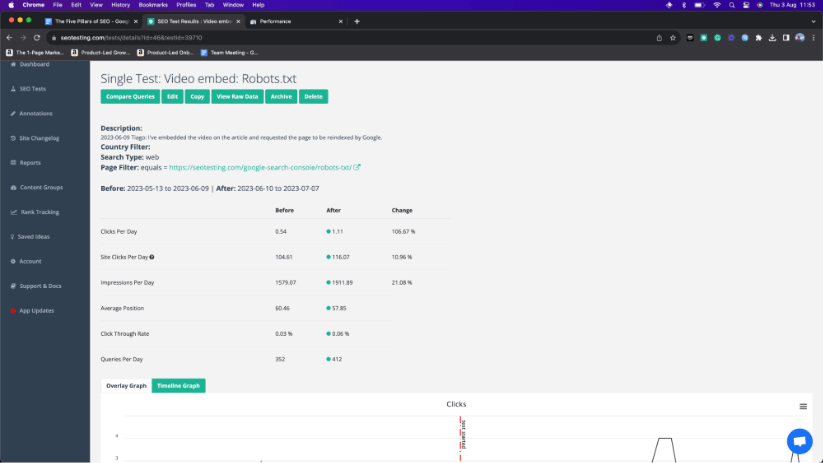
The above shows the test results following embedding a YouTube video onto our article on robots.txt files. As you can see, we had:
- A 106% increase in clicks per day.
- A 21% increase in impressions per day.
- The article's average position improved.
- The article's CTR improved.
We now do this for a lot of our articles, spend the time and the money to create a YouTube video and embed it into our content.
This is just one example of an SEO test you can run to improve content performance.
Reporting
Ensuring you are up to scratch on your reporting is also crucial for anyone involved in a website's SEO success. Whether you are reporting on organic performance as a whole, a subsection of your website or an SEO test you have run, being able to convey the information to stakeholders and management in a clear way is vital.
Some tools will help you do this. Google Analytics and Google Search Console have dashboards that make reading data easy. The trouble is with these tools, it can sometimes take a little time and some expert knowledge to extract the information needed, and then this needs to be presented separately from the tool itself.
There are other tools out there that can be used for reporting, for example, SEOTesting and AgencyAnalytics all work well in their areas. AgencyAnalytics makes it simple, at a glance, for you to see how your website is performing in search and through other facets. SEOTesting has a range of reports you can click on and be immediately taken to a useful report to help you get your message across. The "Brand vs Non-Brand" report is a great example. In one click, you can see exactly how you are performing through brand search and non-brand search:
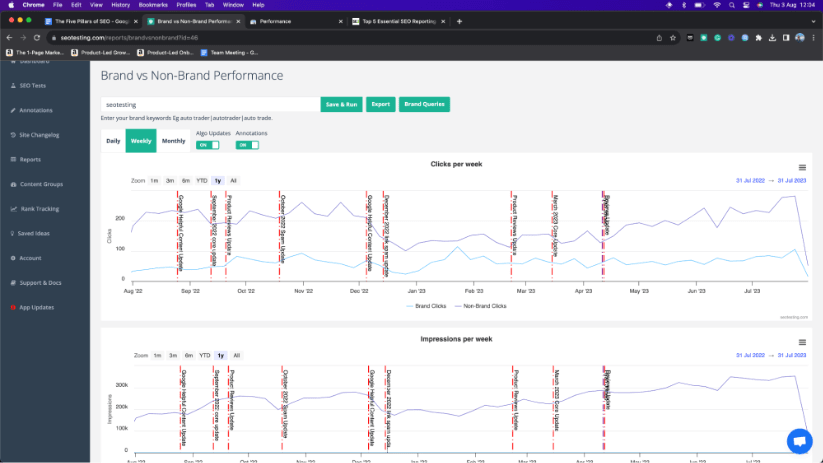
Continuous Improvement & Optimisation
Through comprehensive SEO reporting and testing, you can find ways to improve your organic traffic beyond what you thought possible.
Take the example we used earlier of embedding YouTube videos into blog content. Some businesses may have written the content, built some backlinks and left the organic traffic to grow that way. This may work, but the simple act of adding a YouTube video to the content took it far beyond what the content might have been able to achieve without it.
It's through continuous improvement and optimisation we have been able to create consistent growth for the SEOTesting website. Our website has grown from 0 to over 4,000 organic clicks per month in the space of just over three years.
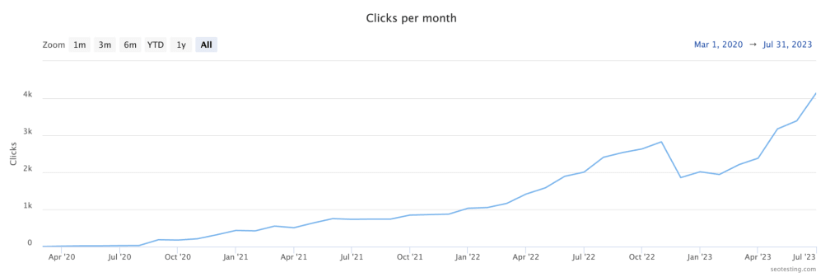
Hopefully, this article has given you more confidence in the things you need to "nail" to create search success for your business. Focussing on these five pillars, as well as having solid foundations and a sturdy roof, will allow you to boost your organic traffic and make more money for your business.
Are you looking to make more use of the data within your Google Search Console account? Consider giving SEOTesting a try! We're not "just" an SEO testing tool, we have a large range of useful reports, all created to help you better prove your value as an SEO. We are currently running a free, 14-day, free trial with no credit card required to sign-up.

